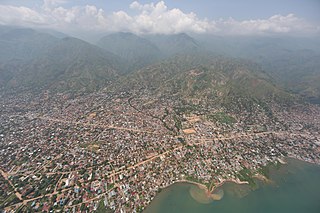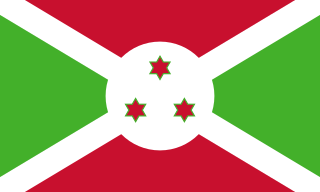
Burundi is located in East Africa, to the east of the Democratic Republic of the Congo, at the coordinates 3°30′S30°0′E.

South Kivu is one of 26 provinces of the Democratic Republic of the Congo (DRC). Its capital is Bukavu.

Burundi is divided into eighteen provinces, each named after their respective capital with the exception of Bujumbura Rural.

Uvira is a city strategically located in the South Kivu Province of the eastern region of the Democratic Republic of the Congo (DRC). It is situated between Lake Tanganyika and the Mitumba Mountains, spanning approximately 16 square kilometers.

The wildlife of Burundi is composed of its flora and fauna. The small, landlocked country is home to 2,950 species of plants, 596 birds, 163 species of mammals, 52 species of reptiles, 56 species of amphibians, and 215 fish species. The wildlife has been drastically reduced in recent years, mainly on account of intense population pressure, conversion of large areas of forest into agricultural land, and extensive livestock farming. The protected area encompasses little more than 5% of the total area of the country.

The Urewe culture developed and spread in and around the Lake Victoria region of Africa during the African Iron Age. The culture's earliest dated artefacts are located in the Kagera Region of Tanzania, and it extended as far west as the Kivu region of the Democratic Republic of the Congo, as far east as the Nyanza and Western provinces of Kenya, and north into Uganda, Rwanda and Burundi. Sites from the Urewe culture date from the Early Iron Age, from the 5th century BC to the 6th century AD. The Urewe people certainly did not disappear, and the continuity of institutional life was never completely broken. One of the most striking things about the Early Iron Age pots and smelting furnaces is that some of them were discovered at sites that the local people still associate with royalty, and still more significant is the continuity of language.

The following outline is provided as an overview of and topical guide to Burundi:

Agriculture in the central African country of Burundi produced in 2018:

Burundi, officially the Republic of Burundi, is a landlocked country in the Great Rift Valley at the junction between the African Great Lakes region and Southeast Africa. It is bordered by Rwanda to the north, Tanzania to the east and southeast, and the Democratic Republic of the Congo to the west; Lake Tanganyika lies along its southwestern border. The capital cities are Gitega and Bujumbura, the latter being the country's largest city.
These are some of the articles related to Burundi on the English Wikipedia:
Nemba is a settlement in Rwanda.
The commune of Bugabira is a commune of Kirundo Province in northern Burundi. The capital is Bugabira. There are health centers at Muyange and Ruhehe.
Busoni is a commune of Kirundo Province in northern Burundi.

The commune of Kirundo is a commune of Kirundo Province in northern Burundi. Settlements include the provincial capital of Kirundo; Rutare, to the north of the airport; and Mutwenzi, near to the Mutwenzi military base.
The commune of Ntega is a commune of Kirundo Province in northern Burundi. The capital lies at Ntega.
The Akanyaru Multipurpose Dam, is a planned dam across the Akanyaru River, at the international border between Rwanda and Burundi. The dam will create a reservoir with storage capacity of 333,000,000 cubic metres (1.1759784018×1010 cu ft). The water is expected to supply drinking water to an estimated 614,200 people in both countries. The reservoir is also expected to provide irrigation water to an estimated 12,474 hectares (30,820 acres) of agricultural land in Burundi and Rwanda, benefitting an estimated 24,948 farmers. The dam will also host Akanyaru Hydroelectric Power Station, with generating capacity of 14.5 MW (19,400 hp).
Alain Tribert Mutabazi is a Burundian politician who was the governor of northern Province of Kirundo and currently serving as Minister of Defense.
Lake Mwungere is a lake in the Kirundo Province of Burundi.
The Murehe Forest, formally the Murehe Reserve, is an area of protected forest in the north of the Kirundo Province of Burundi.
Lake Narungazi is a lake in the Commune of Ntega in Kirundo Province of Burundi.










